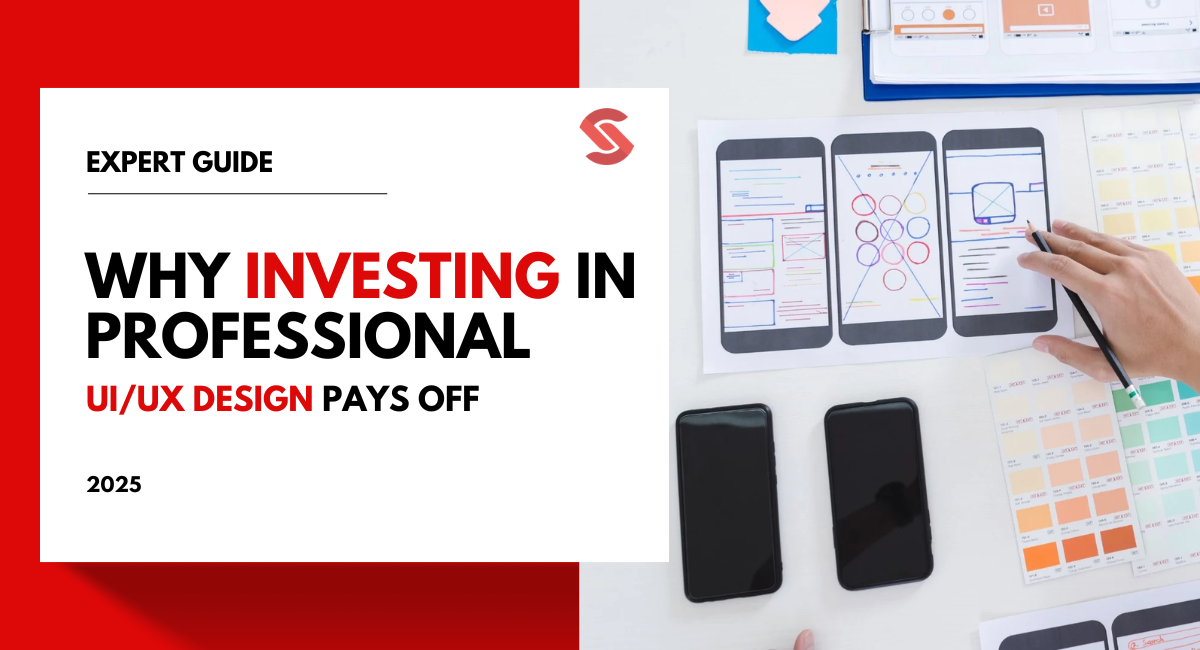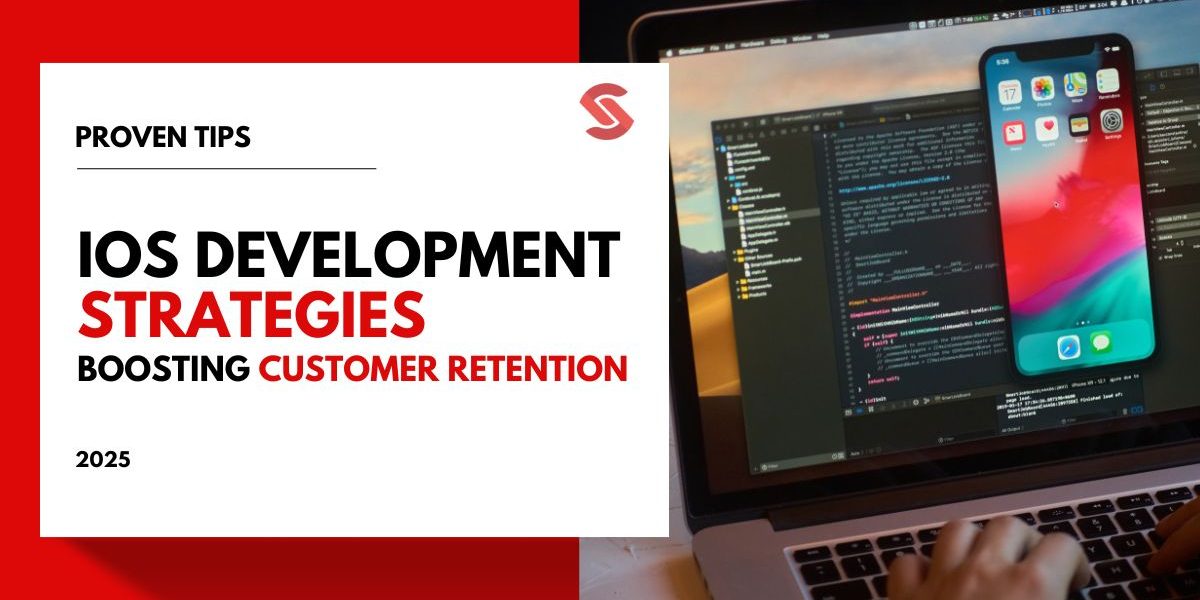Remember the last time you deleted an app in frustration? Chances are it looked great but was a nightmare to use. In 2025, with over 5 million apps competing for attention, the difference between an app people love and one they leave often comes down to a simple truth: how it feels to use it.
Better UI/UX designs are like comfortable shoes; when they fit well, you forget they’re there, but when they don’t, every step is painful.
While some see design as mere aesthetics, savvy companies understand that professional UI/UX is essential; it’s like having a 24/7 sales team that turns first-time visitors into loyal customers.
In this blog, we’ll discuss why investing in professional UI/UX design goes beyond aesthetics. Whether launching a new product or updating an existing one, find out why 2025 is the year to prioritize user experience.
The Critical Role of UI/UX Design in 2025
In 2025, UI/UX design has evolved far beyond pretty buttons and smooth animations. Users today don’t just interact with apps, they live in them.
Every swipe, click, and scroll shapes their opinion of your brand. Not only is a slow checkout process or unclear navigation frustrating, but it’s also the quickest way to lose clients. Take a look at Airbnb’s recent achievements.
Their app makeover in late 2024 increased bookings by 40% by making the search process more intuitive. Meanwhile, its competitor HomeStyle lost a quarter of its users after a rushed, poorly designed update.
The message is clear that your interface is your business card, your storefront, and your customer service desk rolled into one.
Financial and Strategic Benefits of Investing in Professional UI/UX Design

Professional UI/UX design has become a game-changing investment with clear financial rewards. According to Forrester Research’s 2024 UX Impact Report, companies with top-rated user experiences generate 3x more revenue than those with poor design ratings.
Good design does more than please the eye, it slashes support costs, reduces expensive fixes, and drives sales higher.
Companies find that every dollar invested in UX design brings back $100 through increased customer satisfaction and fewer support tickets.
The best part? Great design isn’t an expense, it’s a profit engine that keeps customers coming back for more.
Increased Customer Engagement and Retention
Great UI/UX design speaks directly to the heart of user loyalty. When users find your product easy and enjoyable to use, they stick around longer and come back more often.
Like a well-choreographed dance, good design guides users smoothly through their user journey, turning casual visitors into loyal users. It’s not just about keeping users happy; it’s about creating experiences that make them want to share your product with others.
Higher Conversion Rates
Clear navigation and smart design choices can transform casual browsers into loyal customers.
Every well-placed call-to-action, simplified form, and intuitive menu guides users smoothly toward purchase. When design removes friction points and anticipates user needs, sales naturally follow.
The Importance of UI/UX design for business growth becomes clear in the results: higher conversion rates, more leads, and growing sales prove that good design isn’t just about looks, it’s about making every click count.
Reduction in Development Costs
Neglecting UI/UX design early on often leads to costly, unforeseen issues. Poor usability can frustrate users, lead to redesigns, and extend development timelines. This reactive approach is more expensive than proactive design, hindering long-term growth and user satisfaction.
Benefits of investing in UI UX designs:
- Early Issue Identification: User testing and feedback in the initial stages reveal usability problems, reducing the need for costly post-launch fixes.
- Streamlined Development Process: Clear UI/UX design minimizes back-and-forth among development teams, avoiding delays and inefficiencies.
- Minimizes Redesign Needs: Prototyping uncovers potential issues before full development, allowing for targeted adjustments instead of major redesigns.
- Increases Product Usability: A well-designed interface aligns with user needs, decreasing support requests and ensuring smoother functionality.
- Encourages Effective Extensive Development: Frequent design iterations reduce the need for extensive reworks and related expenses by incorporating feedback gradually.
- Long-term Savings: Investing in UI/UX fosters a product that requires fewer updates, maintenance, and improvements, leading to sustained cost savings over time.
Enhanced Brand Perception
As branding expert Marty Neumeier put it, “A brand is not what you say it is, it’s what they say it is.” UI/UX design is key to building a strong brand image. With good UI/UX, your brand feels reliable and memorable, giving you an edge with a smooth and enjoyable user experience.
A consistent and appealing design creates trust and credibility with users. By focusing on user-friendly and unique design, brands can stand out in a crowded market, creating a visual identity that connects with customers.
Common Mistakes When Skimping on UI/UX Design
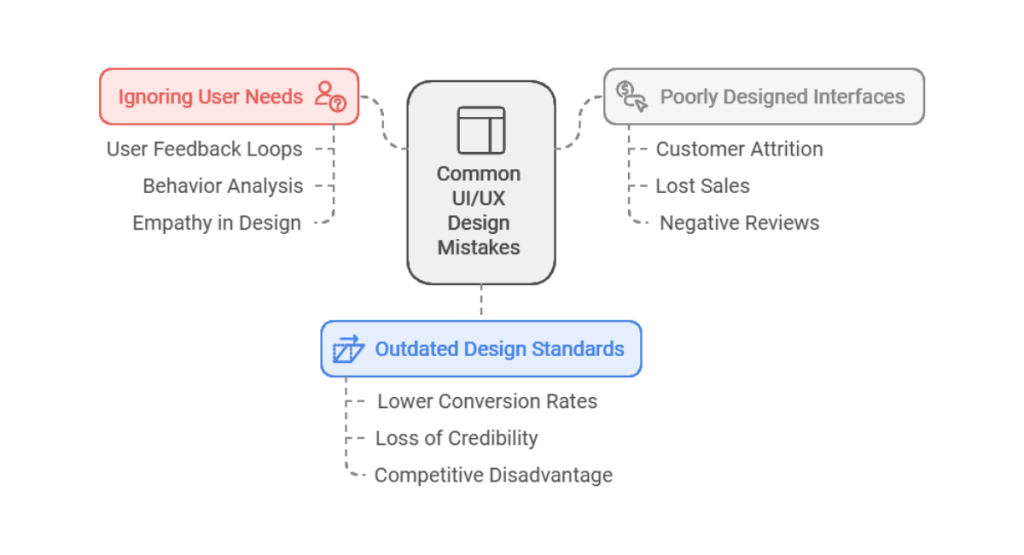
when you are in the business of making money, there’s no room for mistakes, especially when it comes to UI/UX design.
Skimping on design by ignoring user feedback, overlooking trends, or launching poorly planned interfaces can lead to lost customers, lower engagement, and higher costs.
These missteps drive up bounce rates, reduce conversions, and weaken competitive positioning. By avoiding these common mistakes, businesses can protect user satisfaction and strengthen brand reputation, setting the stage for lasting growth.
Ignoring the User in the Design Process
Missing the forest for the trees is all too common when design happens without real user input. Designing without considering user needs and feedback often leads to frustrating, disengaging experiences.
Without feedback loops and behavior analysis, key insights are missed, resulting in avoidable user experience gaps. Understanding user behavior is essential to create intuitive, resonant designs.
As UI/UX expert Don Norman says, “We must design for the way people behave, not for how we would wish them to behave.”
By prioritizing empathy and feedback, businesses can avoid costly usability flaws and build stronger connections with users.
The Cost of Poorly Designed Interfaces
When you want to invest smartly, you don’t break the bank on bad design. Poor UI/UX can be costly, both financially and reputationally. Customer attrition is increased, sales are lost, and trust is harmed by frustrating, difficult-to-navigate interfaces.
Negative user reviews and increased bounce rates hurt brand image, making it harder to retain and attract new customers. Not only is an intuitive design desirable, but it is also necessary to maintain a favorable brand image and foster client loyalty.
Businesses preserve their reputation, increase conversions, and eventually defend their bottom line by emphasizing user-friendly design.
Failing to Keep Up with Design Trends and Standards
Design standards evolve constantly, and failing to keep pace can hurt your business more than you might expect. When your design appears outdated, it creates an immediate negative impression that’s hard to overcome.
- Lower conversion rates from skeptical visitors
- Loss of credibility and professional reputation
- A sharp decrease in user engagement and trust
- Clear competitive disadvantage in the market
- Risk of appearing obsolete or neglected
- Reduced appeal to modern users
Keeping your design fresh and current isn’t just about looking good, it’s about showing users you care about their experience and take your business seriously. Regular updates help maintain user confidence and market relevance.
Key UI/UX Design Trends to Watch in 2025
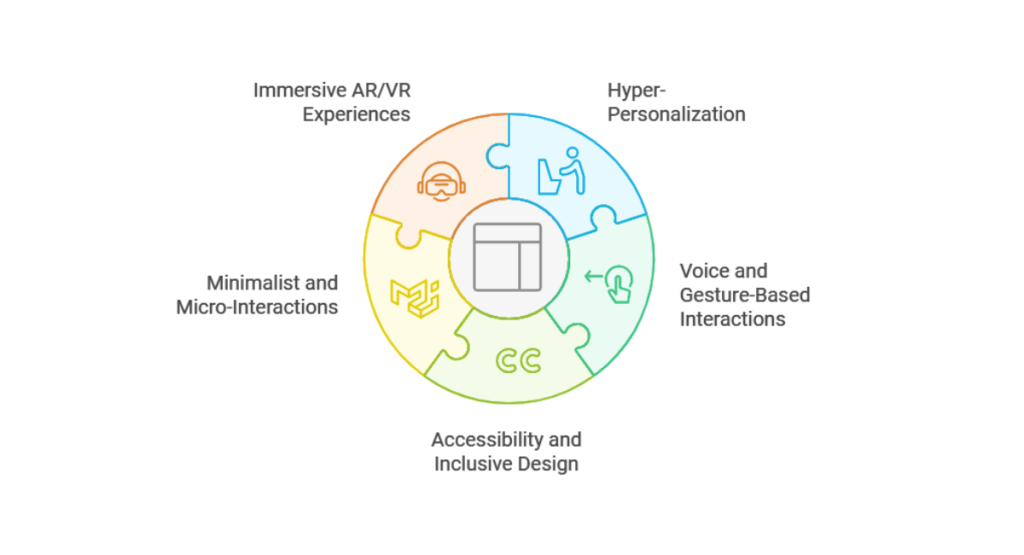
When it comes to staying alive in the market, keeping an eye on the next big thing in UI/UX design can make all the difference in creating standout user experiences. For 2025, we’re seeing major shifts toward AI-powered personalization and immersive technologies that reshape user interactions.
Voice interfaces are becoming smarter, while AR/VR elements blend into everyday apps. Clean, minimal designs now prioritize accessibility and inclusive practices, ensuring digital products work for everyone. These trends focus on creating experiences that are both intuitive and forward-thinking.
Hyper-Personalization Through AI and Data Analytics
Hyper-personalization through AI and machine learning has become a game-changing approach to user experience.
In fact, according to a report by McKinsey, companies that excel at personalization generate 40% more revenue from these efforts compared to those that don’t leverage personalization effectively.
Modern users expect digital products to adapt to their unique needs and habits. AI-driven systems now analyze user behavior and interaction patterns to create real-time, customized experiences, making each journey more engaging.
This shift goes beyond relevant content, it’s about crafting interfaces that feel uniquely customized to each user.
Voice and Gesture-Based Interactions
Voice and gesture controls are quickly transforming how users interact with digital interfaces. Modern users expect more natural ways to control their devices beyond traditional tap and swipe, whether through simple voice commands or intuitive hand movements.
This shift is changing core design principles, pushing interfaces to become more fluid and responsive to human behavior.
From healthcare settings where touchless controls are crucial, to everyday applications that blend voice commands with gesture recognition, these technologies are making digital interactions feel more natural and accessible.
Accessibility and Inclusive Design
Inclusive design has moved from being a nice-to-have to a core requirement in 2025. Digital products must serve all users, regardless of their abilities or limitations.
Smart design choices like proper color contrast, keyboard navigation, and screen reader compatibility aren’t just compliance requirements, they’re essential elements that make products truly universal.
Inclusive design creates better experiences for everyone while ensuring that no user gets left behind. The approach prioritizes different age groups, cognitive abilities, and situational limitations, making digital products more versatile and user-friendly across all demographics.
Minimalist and Micro-Interactions
A “less is more” approach can have a powerful impact on user experience. By combining minimalist design with subtle, well-placed micro-interactions, interfaces become both visually appealing and highly functional. These design choices create fluid, engaging experiences that keep users focused and delighted.
- Reduced Cognitive Load: Simplified designs help users concentrate on essential tasks without overwhelming details.
- Enhanced Engagement: Micro-interactions bring a touch of delight, making interactions feel responsive and satisfying.
- Improved Usability: Minimalist layouts are intuitive and easy to navigate, increasing user satisfaction.
- Clearer Visual Hierarchy: Prioritizing key elements maintains a clean look, guiding users naturally through the interface.
Immersive AR/VR Experiences
AR and VR are revolutionizing digital interactions by blending physical and virtual realities. These technologies create deeper, more engaging user experiences that go beyond traditional screen-based interfaces.
Users can now interact with products in 3D space, test virtual products in real environments, and experience immersive training or entertainment. This shift from 2D to spatial computing is creating new possibilities for how we experience and interact with digital content.
From virtual showrooms and interactive product demonstrations to immersive educational experiences, AR/VR is reshaping user expectations and opening new avenues for engagement across industries.
The Long-Term Return on Investment (ROI) of UI/UX Design
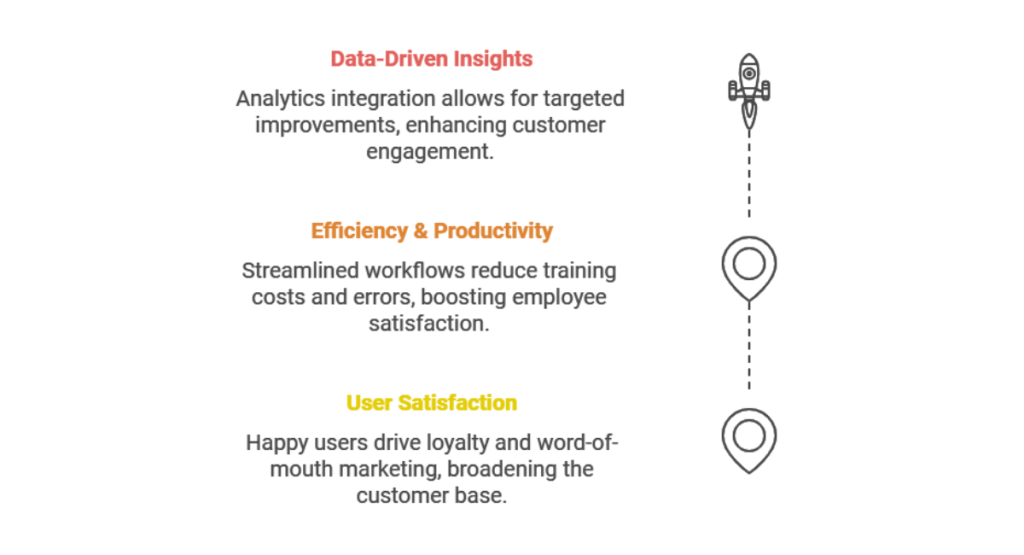
Investing in UI/UX design isn’t just about short-term gains; it’s a long-term strategy that enhances user satisfaction, boosts conversions, and builds strong brand loyalty. Quality UI/UX design helps businesses increase customer retention, attract positive reviews, and reduce the need for costly redesigns.
All of which contribute to consistent revenue growth and a competitive edge. A strong UI/UX strategy secures financial and strategic benefits by supporting sustainable user engagement and a solid brand reputation.
ROI from Increased User Satisfaction
When users have a positive experience, they’re more likely to become loyal customers and advocates for your brand, fueling long-term business growth.
Happy users tend to return frequently, but they also drive word-of-mouth marketing, recommending the product or service to friends and family, which effectively broadens the customer base without added marketing costs.
This level of organic advocacy can lower acquisition expenses while building trust and credibility. High user satisfaction not only enhances lifetime customer value but also strengthens brand reputation, creating a feedback loop of loyalty and sustained growth that continues to deliver returns over time.
ROI from Enhanced Efficiency and Productivity
Optimized UI/UX design doesn’t just benefit customers, it also boosts internal efficiency and productivity. Well-designed interfaces streamline workflows by making tools and processes intuitive and easy to use, which reduces the time employees spend learning or navigating complex systems.
This efficiency lowers training costs and minimizes errors, as employees can quickly adapt and perform tasks more effectively.
An efficient, user-friendly interface improves employee satisfaction and productivity, allowing the team to focus on high-value tasks. Ultimately, this operational boost translates to a measurable ROI, as resources are used more effectively and operational costs decrease.
ROI from Data-Driven Insights
A professionally designed UI/UX isn’t just about aesthetics; it integrates seamlessly with analytics tools to provide valuable, actionable insights into user behavior.
With effective UI/UX design, businesses can track and analyze user interactions to understand preferences, identify pain points, and optimize the user journey.
Research from Forrester found that businesses using data-driven insights in their design processes are 60% more likely to exceed revenue goals, highlighting the powerful impact of data-informed UI/UX decisions on ROI.
These data-driven insights allow for precise, targeted improvements that enhance customer satisfaction and engagement. Working with these insights ensures that the product evolves alongside user needs, driving continued relevance and value.
How to Choose the Right UI/UX Design Partner
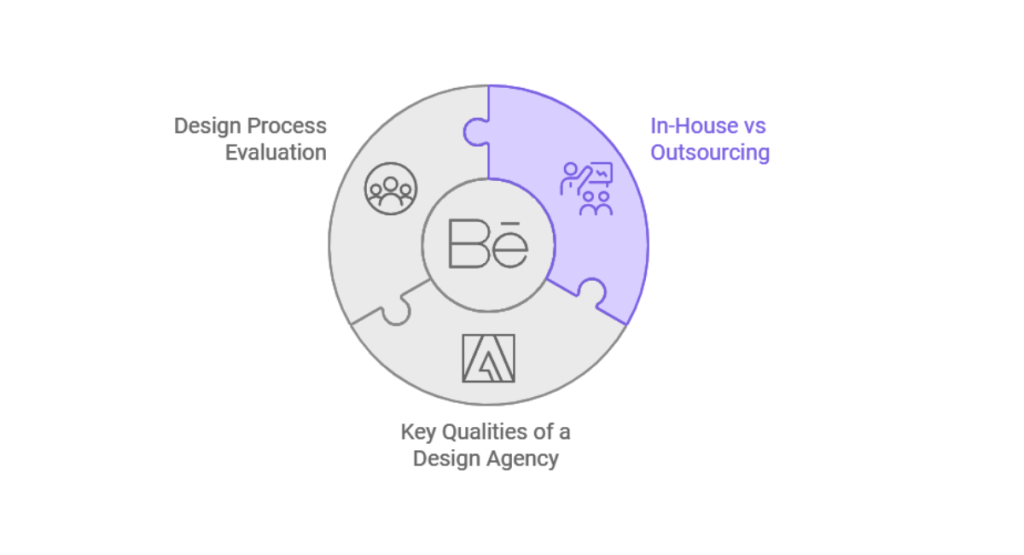
Choosing the right UI/UX design partner is key to building a product that meets user needs and business goals. A good design partner brings both the right skills and a clear understanding of your brand and audience.
They prioritize user needs, listen to feedback, and ensure a smooth design process. With the right team by your side, you get a partner who cares about quality and is focused on helping your business grow and keeping users happy.
In-House vs. Outsourcing: Pros and Cons
Deciding between an in-house UI/UX team and outsourcing to external professionals depends on factors like cost, expertise, and project timelines. In-house teams provide deep brand understanding and ongoing support, while outsourcing can offer specialized expertise and faster scalability.
Here’s a closer look at the pros and cons of each option:
In-House Team
Pros: Deep brand knowledge, faster internal communication, ongoing support, and consistency.
Cons: Higher long-term costs, limited specialized expertise, slower scalability.
Outsourcing
Pros: Access to a broad range of expertise, flexibility in scaling resources, faster time-to-market.
Cons: Less brand familiarity, possible communication challenges, reliance on external timelines, and availability.
What to Look for in a Professional UI/UX Design Agency
Finding the right UI/UX design agency means looking beyond basic skills. A top-tier team will bring experience, a strong portfolio, and a clear understanding of your industry. Their past projects and client reviews should reflect a commitment to quality and a user-centered approach.
Here are some key questions to consider:
- Does their portfolio show versatility and creativity?
- How do they handle client feedback and revisions?
- Do they have experience with projects similar to yours?
- Can they demonstrate knowledge of your industry and audience needs?
Selecting a team with these qualities ensures a partnership that aligns with your goals and user expectations.
The Design Process: From Ideation to Implementation
A professional UI/UX design project typically follows a structured process that brings ideas to life, from initial concepts to the final product.
It begins with an initial consultation to understand your goals and audience, followed by user research to gather insights.
The team then creates wireframes and prototypes to map out the user experience, allowing for feedback and adjustments.
Finally, the design is refined and implemented into a fully functional product. This step-by-step approach ensures that the result meets both user needs and business objectives.
Conclusion
As we move into 2025, investing in quality UI/UX design is essential for any business looking to grow and succeed. Good design improves customer satisfaction, boosts conversions, and builds brand loyalty, a key competitive advantage.
Softnix is here to be your trusted partner in providing exceptional UI/UX design services, we have experience creating user-friendly, impactful designs and understand how to align with your business goals to build meaningful user experiences.
Works for Your Business.
FAQs about Investing in Professional UI/UX Design
How can UI/UX design impact customer loyalty and lifetime value?
In 2025, UI/UX design plays a crucial role in building customer loyalty by creating seamless, enjoyable experiences that keep users engaged. A well-designed interface fosters trust and satisfaction, encouraging users to return and recommend the product, ultimately increasing their lifetime value to the business.
How does AI-powered personalization impact UI/UX design trends in 2025?
AI-powered personalization has become a major trend, with advanced algorithms analyzing user behaviors to deliver customized experiences. This trend helps digital products feel uniquely tailored to each user, increasing engagement and satisfaction.
How can UI/UX design reduce operational costs for a business?
Effective UI/UX design streamlines user journeys, reduces support inquiries, and minimizes the need for extensive post-launch redesigns. By proactively addressing usability issues, businesses save on development and customer support expenses.
What role do micro-interactions play in modern UI/UX design?
Micro-interactions, such as subtle animations and button responses, enhance the user experience by providing feedback, guiding actions, and adding a touch of delight to interactions. They help make the interface feel responsive and engaging.
How can UI/UX design influence brand perception in a crowded digital marketplace?
Good UI/UX design helps create a memorable, reliable brand image that stands out among competitors. A smooth, consistent interface builds trust and credibility, making users more likely to recommend the product to others.
What are the key indicators of poor UI/UX design?
Poor UI/UX design indicators include high bounce rates, low engagement, frequent customer complaints, and a noticeable drop in user retention. Unclear navigation and slow loading times also point to design issues that can drive users away.
How can UI/UX design support e-commerce businesses in boosting conversions?
UI/UX design enhances e-commerce platforms by making navigation intuitive, simplifying checkout processes, and strategically placing calls to action. By removing friction, users can complete purchases easily, directly impacting conversion rates.
Why are companies focusing on accessibility in UI/UX design for 2025?
With a growing focus on inclusivity, companies now prioritize accessibility in UI/UX design to ensure that their products serve a diverse range of users, including those with disabilities. Accessible design not only fulfills legal requirements but also broadens market reach.
What is the impact of failing to keep up with UI/UX design trends?
Outdated UI/UX design can result in lower user engagement, loss of credibility, and a competitive disadvantage. Modern users expect current trends like personalization, minimalism, and voice control, so staying relevant helps retain and attract users.
How can businesses choose the right UI/UX design agency for their needs?
When selecting a UI/UX design agency, businesses should assess the agency’s portfolio, client reviews, industry expertise, and approach to user-centered design. A skilled partner will clearly understand the brand’s goals and audience expectations.

